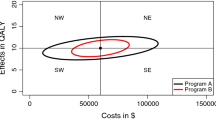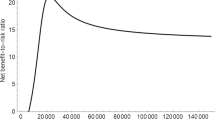Abstract
The league table approach to rank ordering health care programs according to the incremental cost-effectiveness ratio is a common method to guide policy makers in setting priorities for resource allocation. In the presence of uncertainty, however, ranking programs is complicated by the degree of variability associated with each program. Confidence intervals for cost-effectiveness ratios may be overlapping. Moreover, confidence intervals may include negative ratios and the interpretation of negative cost-effectiveness ratios is ambiguous. We suggest to rank mutually exclusive health care programs according to their rate of return which is defined as the net monetary benefit over the costs of the program. However, how does a program with a higher expected return but higher uncertainty compare to a program with a lower expected return but lower risk? In the present paper we propose a risk-adjusted measure to compare the return on investment in health care programs. Financing a health care program is treated as an investment in a risky asset. The risky asset is combined with a risk-free asset in order to construct a combined portfolio. The weights attributed to the risk-free and risky assets are chosen in such a manner that all programs under consideration exhibit the same degree of uncertainty. We can then compare the performance of the individual programs by constructing a risk-adjusted league table of expected returns.
Similar content being viewed by others
References
Al, M. J. (2001). Evaluating Health Care Technologies: Certain Methods for Uncertain Situations. Thesis, Erasmus University Rotterdam, The Netherlands.
Arrow, K. J. and R. C. Lind. (1970). "Risk and Uncertainty: Uncertainty and the Evaluation of Public Investment Decisions." American Economic Review 60, 364–378.
Birch, S. and A. Gafni. (1992). "Cost-Effectiveness/Utility Analyses. Do Current Decision Rules Lead us Where We Want to Be?" Journal of Health Economics 11, 279–296.
Birch, S. and A. Gafni (1993). "Changing the Problem to Fit the Solution: Johannesson and Weinstein's (mis) Application of Economics to Real World Problems." Journal of Health Economics 12, 469–476.
Briggs, A. and P. Fenn. (1998). "Confidence Intervals or Surfaces? Uncertainty on the Cost-Effectiveness Plane." Health Economics 7(8), 723–740.
Bodie, Z., A. Kane and A.J. Marcus. (2002). Investments. Irwin: McGraw-Hill.
Bridges, J. F. P.,M. Stewart, M. T. King and K. van Gool. (2002). "Adapting Portfolio Theory for the Evaluation of Multiple Investments in Health Care with Multiplicative Extension for Treatment Synergies." European Journal of Health Economics 3, 47–53.
Chapman, R. H., P.W. Stone, E. A. Sandberg, C. Bell and P. J. Neumann. (2000). "A Comprehensive League Table of Cost-Utility Ratios and a Sub-Table of 'Panel-Worthy' Studies." Medical Decision Making 20(4), 451–467.
Drummond, M., G. Torrance and J. Mason. (1993). "Cost-Effectiveness League Tables: More Harm than Good?" Social Science & Medicine 37(1), 33–40.
Hutubessy, R. C.W., R. M. P. M. Baltussen, D. B. Evans, J. J. Barendregt and C. J. L. Murray. (2001). "Stochastic League Tables: Communicating Cost-Effectiveness Results to Decision-Makers." Health Economics 10, 473–477.
Mason, J., M. Drummond and G. Torrance. (1993). "Some Guidelines on the Use of Cost Effectiveness League Tables." British Medical Journal 306(6877), 570–572.
O'Brien, B. J. and M. J. Sculpher. (2000). "Building Uncertainty into Cost-Effectiveness Rankings: Portfolio Risk-Return Tradeoffs and Implications for Decision Rules." Medical Care 38(5), 460–468.
Sendi, P. and M. J. Al. (2003). "Revisiting the Decision Rule of Cost-Effectiveness Analysis Under Certainty and Uncertainty." Social Science & Medicine 57, 969–974.
Sendi, P.,A. Gafni and S. Birch. (2002). "Opportunity Costs and Uncertainty in the Economic Evaluation of Health Care Interventions." Health Economics 11, 23–31.
Sendi, P., M. J. Al, A. Gafni and S. Birch. (2004). "Portfolio Theory and the Alternative Decision Rule of Cost-Effectiveness Analysis: Theoretical and Practical Considerations." Social Science & Medicine 58, 1853–1855.
Stinnett, A. A. and J. Mullahy. (1998). "Net Health Benefits: A New Framework for the Analysis of Uncertainty in Cost-Effectiveness Analysis." Medical Decision Making 18(2 Suppl), S68–S80.
van Hout, B. A., M. J. Al, G. S. Gordon and F. F. Rutten (1994). "Costs, Effects and C/E-Ratios Alongside a Clinical Trial." Health Economics 3, 309–319.
Zivin, J. G. (2001). "Cost-Effectiveness Analysis with Risk Aversion." Health Economics 10, 499–508.
Author information
Authors and Affiliations
Rights and permissions
About this article
Cite this article
Sendi, P., Al, M.J. & Zimmermann, H. A Risk-Adjusted Approach to Comparing the Return on Investment in Health Care Programs. International Journal of Health Care Finance and Economics 4, 199–210 (2004). https://doi.org/10.1023/B:IHFE.0000036046.80562.06
Issue Date:
DOI: https://doi.org/10.1023/B:IHFE.0000036046.80562.06




